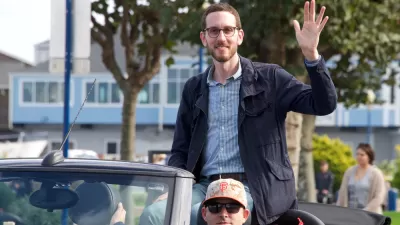For years, the California legislators have been passing bills to allow accessory dwelling units on single-family residential lots. These laws haven't attracted the same attention as other failed laws, but their effect is significant.

Liam Dillon explains the below-the-radar approach to achieving new density statewide in California—instead of the measures proposed by failed legislation that would force dense zoning around transit lines, like SB 827 in 2018 and SB 50 in 2019.
Over the past four years, according to Dillon, "a suite of smaller proposals has quietly chipped away at zoning only for single-family homes, attracting comparably little blowback."
The most recent of these (comparably) consequential but (relatively) clandestine laws were signed by California Governor Gavin Newsom on October 9, 2019. The new laws include "legislation that will allow property owners to build a backyard home of at least 800-square-feet as well as convert a garage, office or spare room into a third living space."
So it might now be as direct as the new comprehensive plan that will allow for three-plexes in all of Minneapolis, but the effect is the same. "The result is a patchwork of legislation that achieves much of what those pushing for more growth in the state have long wanted, allowing as many as three homes on parcels in most single-family neighborhoods across California," writes Dillon.
Ben Metcalf, former director of the state’s Department of Housing and Community Development, is quoted in the article saying the effect of this patchwork has brought the state to the "precipice of single-family zoning functionally not existing."
Dillon also cites Los Angeles as an example of the power that legislation to legalize the construction of accessory dwelling units can have on the building industry: "In Los Angeles, annual permit applications for backyard homes have increased more than 2,000% since the initial state laws took effect. Since 2017, the city has received almost 13,300 requests to build the units."
More specific details of one of the bills signed by Governor Newsom, AB 881, can be found in a separate article by Madeleine Pauker.
FULL STORY: How lawmakers are upending the California lifestyle to fight a housing shortage

Maui's Vacation Rental Debate Turns Ugly
Verbal attacks, misinformation campaigns and fistfights plague a high-stakes debate to convert thousands of vacation rentals into long-term housing.

Planetizen Federal Action Tracker
A weekly monitor of how Trump’s orders and actions are impacting planners and planning in America.

San Francisco Suspends Traffic Calming Amidst Record Deaths
Citing “a challenging fiscal landscape,” the city will cease the program on the heels of 42 traffic deaths, including 24 pedestrians.

Defunct Pittsburgh Power Plant to Become Residential Tower
A decommissioned steam heat plant will be redeveloped into almost 100 affordable housing units.

Trump Prompts Restructuring of Transportation Research Board in “Unprecedented Overreach”
The TRB has eliminated more than half of its committees including those focused on climate, equity, and cities.

Amtrak Rolls Out New Orleans to Alabama “Mardi Gras” Train
The new service will operate morning and evening departures between Mobile and New Orleans.
Urban Design for Planners 1: Software Tools
This six-course series explores essential urban design concepts using open source software and equips planners with the tools they need to participate fully in the urban design process.
Planning for Universal Design
Learn the tools for implementing Universal Design in planning regulations.
Heyer Gruel & Associates PA
JM Goldson LLC
Custer County Colorado
City of Camden Redevelopment Agency
City of Astoria
Transportation Research & Education Center (TREC) at Portland State University
Jefferson Parish Government
Camden Redevelopment Agency
City of Claremont





























